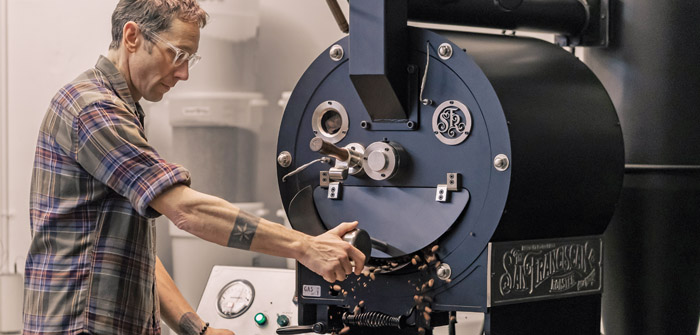(R.C. Gartrell oversees drum roasting of the raw beans to highlight their intrinsic flavors and aromas | Photo courtesy of Seahorse Chocolate)
“I love things that taste good,” said R.C. Gartrell, co-founder (with his partner Amanda Gartrell) of Seahorse Chocolate in Bend. “Even as a young man, I was partial to the flavors of coffee, beer, and chocolate, and at school was the kid who traded his lunch candy to anyone who had Hershey’s Special Dark Chocolate mini-bars. Similarly, since starting up our business almost five years ago, our goal has always been pretty simple — make really tasty chocolate.”
Gartrell, who grew up in Portland, initially rode “the 90’s wave of the coffee revolution,” and “as an early devotee,” played a role in creating three well-known local brands: Tomboy, Hopscotch, and Stumptown Coffee roasters. Years of success later, “with two kids and wife in tow, he took a daredevil jump into the world of cocoa,” to use his own words, and relocated from Colorado to Bend.
“I wanted to try my hand at chocolate,” Gartrell said. “They’re both sourced between tropics, how different could it be? Turns out, quite a bit! But I kept doing it, and the chocolate kept tasting better and better.”
Customers agree, and Gartrell “really likes the ‘ah ha’ moment when they ask ‘why is this so different? How are you doing this with chocolate?’”
He explained that “It’s almost always the case that food that is taken care of will taste better, and cacao is no exception. However, the care it takes to grow really good cocoa — in terms of allocating more time and attention to detail — results in the price point being a lot higher.”
To elaborate, “We carefully select the farms from which our cacao beans are sourced, with a focus on direct trade, responsible farming practices, sustainability, and the economic well-being of the farming families,” Gartrell said. “For example, to ensure that the land is not over-farmed, while secondary crops such as guava, coffee, bananas, and cashews put nutrients back in the soil.”
Even so, there’s no guarantee. As he added, “In farming, profits change constantly. Cocoa farmers get two to three pickings a year, and the same product can be drastically different depending on factors affecting it such as drought and water. In addition, both the trees and pods are fragile and prone to disease, making producing cocoa extremely labor-intensive during cultivation and during the initial processing. Even the phase when the farmer ferments and harvests the cacao pods can make a difference.”
At this point, Gartrell, with his years of roasting experience, enters the scene, and oversees drum roasting of the raw beans to highlight the flavors and aromas intrinsic to their regional characteristics. “I can do a lot during the roasting process, such as working with fat and moisture content, to develop the chocolate’s complex profile,” Gartrell said. Other phases follow — cracking the beans from their hull, winnowing hulls and nibs from the husk, stone grinding the nibs (or conching), and tempering — before the labor-intensive process is complete.
Gartrell pointed out that “Cheaper chocolates often use lower-quality cacao beans and fillers like excessive sugar, vegetable oils, and artificial flavors to make the poor flavor profile — which significantly reduces production costs. “Even labels such as ‘fair trade’ and ‘organic’ don’t tell the entire story,” he warned. “As with any food product, consumers have to do more digging by, for example, carefully reading product labels. (For example, ‘juice’ is only required to have ten percent actual juice.)”
In contrast to adding fillers, “We use just two ingredients at Seahorse Chocolate, Gartrell said, “cocoa beans and organic cane sugar. So the percentage of chocolate in our products is accurately reflected on their labels.”
In his opinion, the market for high-quality chocolate is “just getting started. It reminds me of the late 90s, and the coffee and beer world (e.g., Stumptown in coffee and Sierra Nevada in brewing — both of which emphasized sustainability, and entailed educating the palettes of the public). I have no illusion that our product will be sold to the majority of people,” he said, “but rather to those who want to taste and buy something better.”
Seahorse Chocolate sells only four flavors of dark chocolate — Vietnam-Dak Lak 70%, Peru-Tsirairi 70%, Dominican Republic 70%, and Vietnam 100% (sugar free); and two blends — Left of the Dial 78%., and A.M. Gold 69%. Also available are Dark Milk 65% made with vegan coconut milk, and Hot Cocoa Drink Mix. As Gartrell explained, “I don’t want a big menu. I like having control, and am constantly trying to make the product better and better.”
These efforts — augmented by those of his partner Amanda, an integral part of the business, and their two children, both of whom help with spoon licking, wrapping the finished bars, and other tasks — have garnered awards and placement in stores nationwide. These include multiple sites in Portland and Bend (56 and counting), as well as locations in San Francisco, Colorado, New York City, and even Columbus, Ohio and Winchester, Va. Gartrell noted that Seahorse Chocolate does not use distributors, and markets solely through word of mouth.
“Now I really can’t eat any other chocolate (and be happy),” said one reviewer. “Great chocolate — like Seahorse — is transformative.” Praised another: “Honestly the best chocolate I have ever had.”




